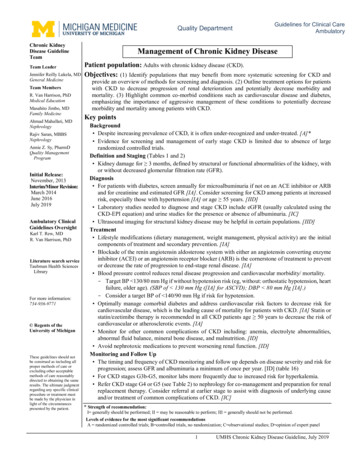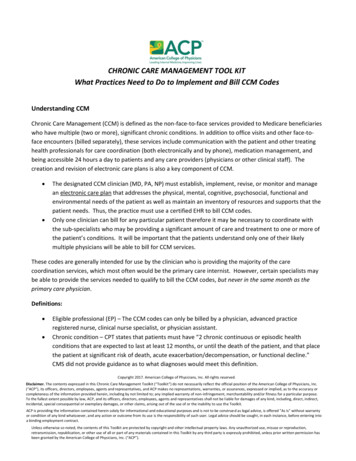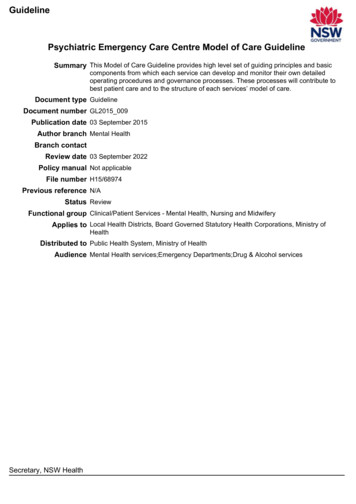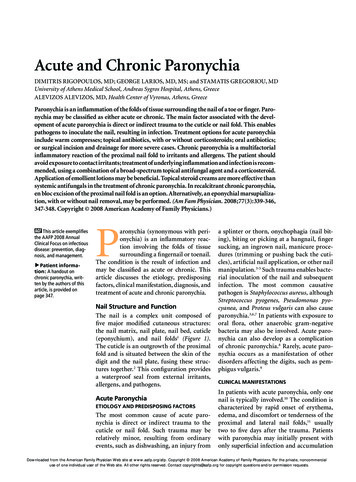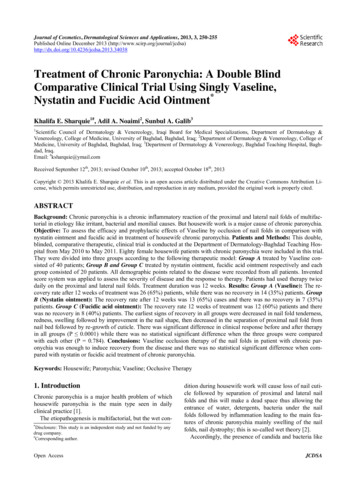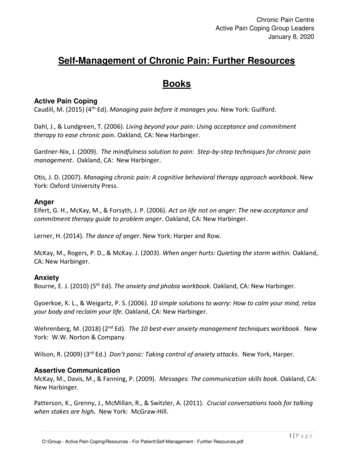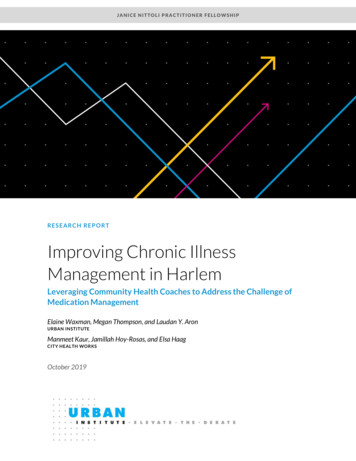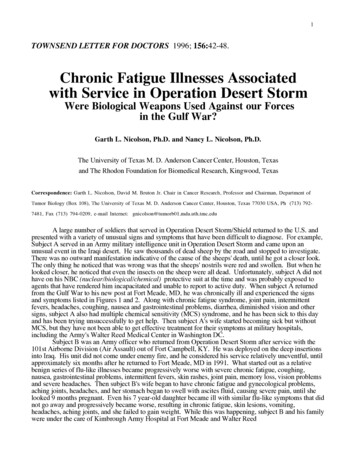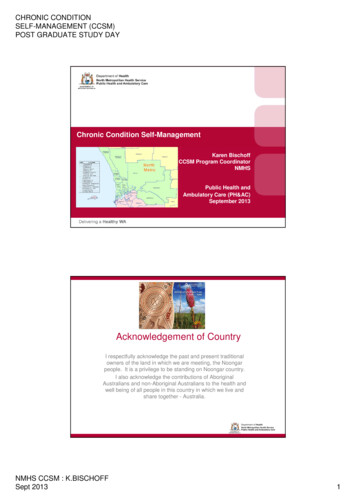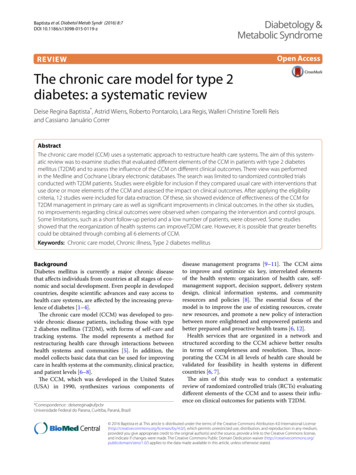
Transcription
Diabetology &Metabolic SyndromeBaptista et al. Diabetol Metab Syndr (2016) 8:7DOI 10.1186/s13098-015-0119-zOpen AccessREVIEWThe chronic care model for type 2diabetes: a systematic reviewDeise Regina Baptista*, Astrid Wiens, Roberto Pontarolo, Lara Regis, Walleri Christine Torelli Reisand Cassiano Januário CorrerAbstractThe chronic care model (CCM) uses a systematic approach to restructure health care systems. The aim of this systematic review was to examine studies that evaluated different elements of the CCM in patients with type 2 diabetesmellitus (T2DM) and to assess the influence of the CCM on different clinical outcomes. There view was performedin the Medline and Cochrane Library electronic databases. The search was limited to randomized controlled trialsconducted with T2DM patients. Studies were eligible for inclusion if they compared usual care with interventions thatuse done or more elements of the CCM and assessed the impact on clinical outcomes. After applying the eligibilitycriteria, 12 studies were included for data extraction. Of these, six showed evidence of effectiveness of the CCM forT2DM management in primary care as well as significant improvements in clinical outcomes. In the other six studies,no improvements regarding clinical outcomes were observed when comparing the intervention and control groups.Some limitations, such as a short follow-up period and a low number of patients, were observed. Some studiesshowed that the reorganization of health systems can improveT2DM care. However, it is possible that greater benefitscould be obtained through combing all 6 elements of CCM.Keywords: Chronic care model, Chronic illness, Type 2 diabetes mellitusBackgroundDiabetes mellitus is currently a major chronic diseasethat affects individuals from countries at all stages of economic and social development. Even people in developedcountries, despite scientific advances and easy access tohealth care systems, are affected by the increasing prevalence of diabetes [1–4].The chronic care model (CCM) was developed to provide chronic disease patients, including those with type2 diabetes mellitus (T2DM), with forms of self-care andtracking systems. The model represents a method forrestructuring health care through interactions betweenhealth systems and communities [5]. In addition, themodel collects basic data that can be used for improvingcare in health systems at the community, clinical practice,and patient levels [6–8].The CCM, which was developed in the United States(USA) in 1990, synthesizes various components of*Correspondence: deiseregina@ufpr.brUniversidade Federal do Parana, Curitiba, Paraná, Brazildisease management programs [9–11]. The CCM aimsto improve and optimize six key, interrelated elementsof the health system: organization of health care, selfmanagement support, decision support, delivery systemdesign, clinical information systems, and communityresources and policies [8]. The essential focus of themodel is to improve the use of existing resources, createnew resources, and promote a new policy of interactionbetween more enlightened and empowered patients andbetter prepared and proactive health teams [6, 12].Health services that are organized in a network andstructured according to the CCM achieve better resultsin terms of completeness and resolution. Thus, incorporating the CCM in all levels of health care should bevalidated for feasibility in health systems in differentcountries [6, 7].The aim of this study was to conduct a systematicreview of randomized controlled trials (RCTs) evaluatingdifferent elements of the CCM and to assess their influence on clinical outcomes for patients with T2DM. 2016 Baptista et al. This article is distributed under the terms of the Creative Commons Attribution 4.0 International /), which permits unrestricted use, distribution, and reproduction in any medium,provided you give appropriate credit to the original author(s) and the source, provide a link to the Creative Commons license,and indicate if changes were made. The Creative Commons Public Domain Dedication waiver ) applies to the data made available in this article, unless otherwise stated.
Baptista et al. Diabetol Metab Syndr (2016) 8:7MethodsA systematic review was performed searching the Medline and Cochrane Library databases, were used thedescribers: chronic care model, diabetes, chronic diseasemanagement, chronic illness model, chronic illness care,chronic illness management, chronic disease, chronicdisease care and healthcare. The search was limited toRCTs that compared two groups of patients with T2DM:those in an intervention group, consisting of one or moreelements of the CCM, and those in a control group, consisting of usual care for the pathology. Additional searchwas conducted by manual search and gray literature.Two reviewers conducted independent searches untilMay 2014 and included all articles published in English,Spanish, or Portuguese without restriction on publication date. If a lack of consensus between the two reviewers occurred, regardless of the stage of the study, a thirdreviewer was consulted.RCTs were included if they were conducted over a3 month period and evaluated the effects of the CCMon primary clinical outcomes (mortality) or intermediate clinical outcomes (HbA1c). RCTs were excluded if thearticles that were not available in the full version (i.e., theabstract only), were clinical trials with patients with type1 diabetes mellitus (T1DM), or evaluated patients lessthan 18 years old or patients with other chronic diseases.Articles describing the study protocol without presentingresults and studies without clinical outcomes were alsoexcluded.Data related to the study duration, number of patients,study location, patient demographic characteristics, typeof intervention conducted, and the CCM elements usedwere collected from the included studies. Data regarding how the implementation of the CCM affected theprimary and intermediate clinical outcomes, beyond theconclusion of each study, were also extracted. Data werecollected for further discussion.ReviewBased on the titles and abstracts, 273 studies were foundand included for the first screening. Of these, 10 wereduplicates and 237 articles were excluded based onthe afore mentioned criteria (13 studies were not randomized, 160 evaluated other pathologies, 44 describedonly the protocol, one did not include clinical outcomes,three lasted less than 3 months, six were not available asfull text (even after contact with the author), three evaluated T1DM, six did not evaluate the CCM, and one studywas not completed). Therefore, 26 articles were includedfor thorough evaluation and, of these, 12 were includedfor data extraction (Fig. 1).Characteristic of the included studies are presentedin Table 1. Only one study reported blinding of bothPage 2 of 7Records identified through database searching(n 273)Records excluded(n 10)Records after duplicates removed(n 263)Records excluded(n 237)Full-text articles assessed for eligibility(n 26)Full-text articles excluded(n 14)Studies included in quantitative synthesis(n 12)Fig. 1 Systematic review flowchart for the chronic care model usedin type 2 diabetes mellitus managementpatients and data collectors [13] and one other study [14]reported blinding of patients only.Regarding the study setting, two studies were conducted at private clinics [15, 16] in Pennsylvania, USA.Two studies were in community health clinics, one in SanFrancisco, USA [17] and one in Michigan, USA [18]. Onestudy was conducted in a health maintenance organization in the USA [7], another in general outpatient clinics in Hong Kong [13], and the remaining six wereconducted in primary care clinics [14, 19–23].The average age of participants in the interventiongroup ranged between 52 and 69 years, although agewas not reported in two studies [13, 20], and 32–56 % ofpatients in the intervention groups were male [20]. Theduration of the interventions ranged from 4 months to5 years.CCM elementsOrganization of health care servicesThe implementation of changes to the CCM (Fig. 2) byleaders in each health care organization was considereda health priority and a vital part of each organizations’strategic plans in all studies [14–24]. The organizationof health care services should focus on creating a cultureand mechanisms that promote safe, high quality care. Toenhance health care, improvements to service organization, introduction of strategies to facilitate changes, andmanagement of errors and quality control problems arealso necessary. Problems of miscommunication andcoordination of health care must be prevented throughagreements that facilitate communication and the flow
886119197639247533946347869157119Glasgow et al. [21]Piatt et al. [16]Hiss et al. [18]Smith et al. [19]Goderis et al. [14]Schillinger et al. [17]Glasgow et al. [23]Carter et al. [22]Foy et al. [20]Lee et al. [13]Piatt [15]Mean age of intervention group: 69 yearsMales in intervention group: 53.3 %Mean age not reportedMales in intervention group: 39.1 %NRMean age of intervention group: 52 yearsMales in intervention group: 30.7 %Mean age of intervention group: 58.7 yearsMales in intervention group: 55.4 %Mean age of participants: 56.1 yearsMales in intervention group: 41 %Mean age of intervention group: 68 yearsMales in intervention group: 47 %Mean age of intervention group: 62 yearsMales in intervention group: 45 %Mean age of intervention group: 55.7 yearsMales in intervention group: 32 %Mean age of intervention group: 69 yearsMales in intervention group: 53.3 %Mean age of intervention group: 62 yearsMales in intervention group: 47.7 %Mean age of intervention group: 61.2 yearsMales in intervention group: 56 %Demographic characteristics(age and gender)3 years28 weeks5 years9 months4 months1 year18 months21 months(range 3–36 months)6 months1 year6 months24 monthsStudy durationBP less than 130/80 and achieving a BMIbetween 18.5 and 24.9HbA1c, BMI, lipids, and BPHbA1C, SBP, DBP, and BMIHDL-C, total cholesterol, DPB, weight,smoking status, statin and antiplatelettherapy efficacyBP, HbA1c, LDL-C, creatinine, and microalbumin levelsNRQuality of life and glycemic self-monitoringQuality of life, biologic outcomes (lipidsand HbA1c levels), and depressivesymptomsCES-D, HbA1c, total cholesterol, number ofvisits and hospitalizationSecondary outcomesSustained improvements in HbA1C, non-HDL-C,and BP levels at 3 year follow-upDiabetes knowledge, empowerment, quality of life, and self-monitoring of glycemiaHbA1c concentration, DM self-efficacy scale,Lifestyle changes (e.g., eating habits)dietary behaviors, BMI, and waist circumferenceMean HbA1c, cholesterol, and BP levels, andThe number of patients within targetnumbers of patients with recorded foot inspecranges for HbA1c, cholesterol, and BP;tions in the previous calendar monththe number of HbA1c, cholesterol, andACR tests requested; and the meanpractice BP levels for patients with andwithout recorded microalbuminuriaHbA1c level of 7 % or less1-year change in self-management behaviorHbA1c, SBP, and LDL-C levelsThe process of diabetes care, metabolic and vascular risk factor control, and the cost of careHbA1C, BP, and cholesterolHbA1c, LDL-C, and BPImproving both laboratory assays and patientcentered aspects of care3 scales of SF-36 (general health, physical function, and physical role function), the presenceof bed disability, and restricted-activity daysPrimary outcomesSF short form health survey; CES-D center for epidemiologic studies depression scale; HbA1c glycated hemoglobin; LDL-C low-density lipoprotein cholesterol; BP blood pressure; NR not reported; SBP systolic bloodpressure; HDL-C high-density lipoprotein cholesterol; DBP diastolic blood pressure; BMI body mass index; ACR albumin/creatinine ratio; DM diabetes mellitusAdapted from Wagner et al. [7]707Number ofparticipantsWagner et al. [7]ReferencesTable 1 Characteristics of included randomized control trialsBaptista et al. Diabetol Metab Syndr (2016) 8:7Page 3 of 7
Baptista et al. Diabetol Metab Syndr (2016) 8:7Page 4 of 7Clinical information systemsFig. 2 The chronic care modelof information between managers and service providers.Effective care for chronic conditions is virtually impossible without an information system to ensure ready accessto key data from populations, subpopulations, and individuals [24–28].Self‑care supportTen studies addressed health service user empowermentfor patients who self-manage their health care [7, 14–18,21–23]. Interventions targeted user empowerment byemphasizing the role of users in managing their ownhealth, the use of support strategies for self-care (includingassessment of health status), goal setting, plan of care preparation and monitoring. The interventions were examinedfor recognition of the central role of users in their healthcare and development of a sense of self-responsibilityrelated to health including regular use of evidence-basedsupport programs that provided information, emotionalsupport, and strategies for living with chronic conditions.Both the patient and provider should be included in defining problems, setting priorities, proposing goals, developing care plans, and monitoring results for self-care. Healthprofessionals should prioritize collaborative care management so that prescribers become partners with health caresystem users [25, 27–31].Clinical decision supportChanges to clinical decision support promoted consistent attention in everyday practice of health care systemsthrough the introduction of scientifically based clinical guidelines. In the 12 studies evaluated, changes inthe behavior of health professionals were observed [13–24]. To increase user understanding, clinical decisionsshould be discussed and made together with the users.To change practices, clinical guidelines should includesystem alerts, reminders, and feedback [19, 25, 26,
The chronic care model (CCM) uses a systematic approach to restructure health care systems. The aim of this system-atic review was to examine studies that evaluated different elements of the CCM in patients with type 2 diabetes mellitus (T2DM) and to assess the influence of the CCM on different clinical outcomes. There view was performedCited by: 107Publish Year: 2016Author: Deise Regina Baptista, Astrid Wiens, Roberto Pontarolo, Lara Regis, Walleri Christine Torelli Reis, .
